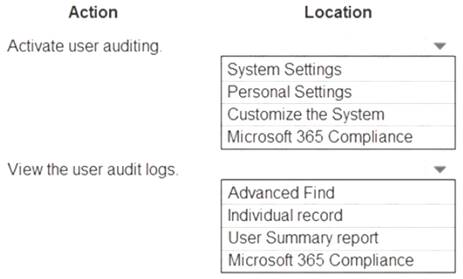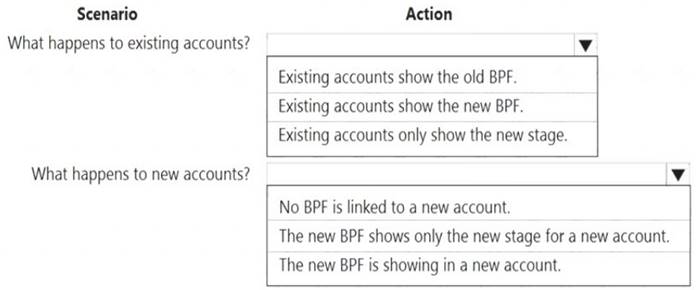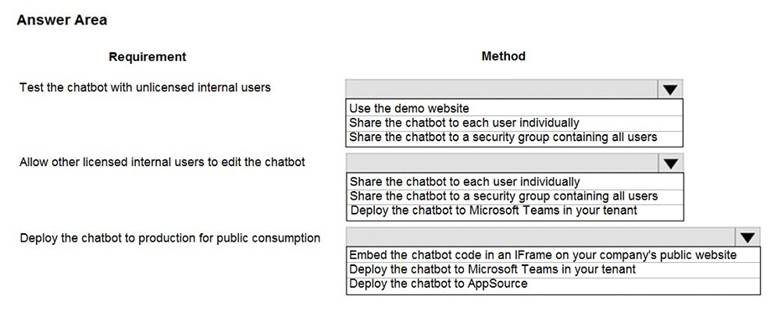- (Exam Topic 3)
A company plans to implement chatbots by using Power Virtual Agents. The company has the following requirements for the bots:
• Users in the accounting department must be able to create a bot for frequently asked questions.
• The support desk users must be able to use the bot.
The users must not be able to change environment parameters in the Microsoft Power Platform environment. You need to configure the permissions for the bots.
Which actions should you implement? To answer, select the appropriate options in the answer area. NOTE: Each correct selection is worth one point.
Solution:
Does this meet the goal?
Correct Answer:
A
- (Exam Topic 3)
You are a Dynamics 365 for Customer Service administrator.
You must create a form for team members to use. The form must provide the ability to:  Lock a field on a form.
Lock a field on a form. Trigger business logic based on a field value.
Trigger business logic based on a field value. Use existing business information to enhance data entry.
Use existing business information to enhance data entry.
You need to implement business rule components to create the form.
Which components should you use? To answer, drag the appropriate components to the correct requirements. Each component may be used once, more than once, or not at all. You may need to drag the split bar between panes or scroll to view content.
NOTE: Each correct selection is worth one point.
Solution: Action
Action Condition
Condition Recommendation
Recommendation
Does this meet the goal?
Correct Answer:
A
- (Exam Topic 3)
You create a JavaScript web resource named MyBusinessLogic. The code it contains uses functionality from a third-party JavaScript library.
You notice that an independent software vendor (ISV) solution uses the same third-party library in their managed solution.
You plan to deploy your solution to other environments by using a managed solution. The ISV solution might not be installed in the other environments.
You need to package the solution for deployment
What are two ways to achieve this goal? Each correct answer presents a complete solution.
NOTE: Each correct selection is worth one point.
Correct Answer:
AC
Web resources in model-driven apps.
Web resources are virtual files that are stored in the Microsoft Dataverse database and that you can retrieve by using a unique URL address.
Capabilities of web resources.
Web resources represent files that can be used to extend the Dataverse web application such as html files, JavaScript, and CSS, and several image formats.
Reference: https://docs.microsoft.com/en-us/power-apps/developer/model-driven-apps/web-resources
- (Exam Topic 3)
You have a business process flow (BPF) that interacts with the Account entity. You configure a new version for the BPF and add a new stage at the beginning. You need to identify the impact of the new version on the existing account records.
What is the outcome in each scenario? To answer, select the appropriate options in the answer area. NOTE: Each correct selection is worth one point.
Solution:
Graphical user interface, text Description automatically generated
Box 1: Existing accounts show the new BPF.
When an entity record is being created and if there are multiple BPFs defined on that entity. The system would do the following:
If the ProcessId field is set to Guid.Empty. The system will skip defaulting the BPF on that instance.
If the ProcessId field is set to specific BPF entity reference. The system will default to the specified BPF. If the ProcessId field on the record is not set. The system will default the BPF.
Box 2: No BPF is linked to a new account.
Note: A business process flow definition is represented as a custom entity and an instance of a process is stored as a record within that entity. Each record is associated with a data record (such as an Account, Contact, Lead, or Opportunity) and in case of cross-entity processes, with a data record for each participating entity.
Reference:
https://docs.microsoft.com/en-us/dynamics365/customerengagement/on-premises/customize/business-process-fl
Does this meet the goal?
Correct Answer:
A
- (Exam Topic 3)
You create a new Power Virtual Agents chatbot for an organization. Testing and production deployment of the chatbot are not complete. You need to ensure that appropriate users can access the chatbot.
Which methods should you use? To answer, select the appropriate options in the answer area.
NOTE: Each correct selection is worth one point.
Solution:
Graphical user interface, application Description automatically generated
Box 1: Use the demo website
When publishing the bot to the web, you can publish to a prebuilt demo website (which you can use to share the bot with your teammates and stakeholders) and to your own live website.
Box 2: Share the chatbot to a security group containing all users.
A license for each user, also known as a "per user license" (or "Power Virtual Agent User License" as referred
to on the Microsoft 365 admin center), should be assigned to individual users who need access to create and manage chatbots.
To simplify user license management, you can assign licenses to an Azure Active Directory (Azure AD) security group.
Box 3: Embed the chatbot code in an IFRame on your copany's public website
You can add your bot to a live website as an IFrame. Your live website can be a customer-facing external website or an internal site, like a SharePoint or Yammer site.
Reference:
https://docs.microsoft.com/en-us/power-virtual-agents/publication-connect-bot-to-web-channels https://docs.microsoft.com/en-us/power-virtual-agents/requirements-licensing
Does this meet the goal?
Correct Answer:
A